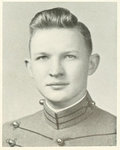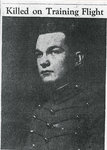


The following article is an abridged version of an essay. A presentation based on this topic was recently given at the Delaware County Historical Association annual meeting in Delhi Nov. 6.
When I was a budding historian back in 2014, Town of Bovina Historian Ray LaFever got me interested in investigating a World War II plane crash that had occurred in the town in 1945. Ray and several others had attempted to locate the precise location of the Bovina crash to no avail. Using a metal detector, Ray and I were able to locate the crash site in Bovina after unearthing several clipped aviation wires.
The story behind the accident was a poignant one - the pilot involved in the deadly crash was 19-year-old West Point Cadet Robert Clark of Nebraska. He was described by friends as “a hard worker with a positive outlook on life.” On April 29, 1945, a few weeks before Clark was to graduate, he had 141 hours of flight training under his belt. Just a few more and he would earn his pilot’s wings. Clark was stationed at Stewart Field in Newburgh, and set out that night on a training flight to Bolling Field, Washington, D.C. Clark had experience flying at night, but the weather April 29 was far from ideal. At 9 p.m., showers and clouds obscured the sky, forcing Clark to navigate solely with instruments, a task with which the young man had little experience.
With darkness and the weather wreaking havoc on Clark’s single-person T-6 Texan Trainer aircraft, the young man became lost. Clark looked to put his training to the test; if he was lost, he could find an alternative place to land. Unfortunately for Clark, around midnight his plane became lost in the Catskill Mountains of New York where few landing opportunities existed. In a last-ditch effort to view his surroundings, Clark dipped his plane below the cloud cover and crashed into the side of a mountain. The plane tore down trees and lost a wing in its violent descent. Clark’s body was not discovered until the next day, but officials believe the young man died on impact. The cause of the crash was listed as “pilot error.”
The Catskill Mountain News published a front-page story May 4, 1945, detailing the events of the crash and the recovery of the wreckage. The bold headline declared, “Plane Wrecked Pilot Killed In Wilds of Bovina,” and gives a timeline of the town’s reaction to the event. Stanley Cronk and Earl Craft of nearby Bloomville “ear-witnessed” the crash, as did Howard LaFever of Bovina. Someone notified the police, and a search for the wreckage began. Searchers discovered the plane on Bramley Mountain at 2 a.m. Monday; the plane left behind an enormous debris field and toppled numerous large trees.
Two truckloads of soldiers from Stewart Field arrived and dealt with the body of Robert Clark. The Army kept curious onlookers at bay, and returned later on in the week to clean up the wreckage. The Army would not get all of the wreckage. The immense debris field allowed certain pieces of the crash to be collected by curious locals as souvenirs. Thirteen year-old Charlie LaFever carried off a 43 pound engine component that currently resides in the Bovina town museum.
After hearing this story from Charlie LaFever’s son Ray, I was inspired to research other World War II-era plane crashes that occurred in New York state.
During the course of my research I discovered numerous crashes throughout the state, but the one that stands out most vividly is another crash that happened in the Catskills, and shares similar details to that of the Clark accident.
This particular crash took place in Ulster County in 1942. On Dec. 11, the Catskill Mountain News front page carried the headline “Lost Army Plane May Have Crashed on Catskill Peak.” The training plane contained a single individual, trainee pilot Robert E. Horn of Nyack, a student at West Point. The week prior, a group of trainees were sent on a practice flight from Newburgh to Amsterdam. Horn’s plane never made it to Amsterdam. After discovering Horn missing, the Army deployed an aerial search party and forest rangers took up the search on foot.
Residents of Big Indian reported seeing a plane in the area that “seemed to fly as though confused.” Another resident reported an eerie glow in the sky the day Horn went missing, and raised the possibility that this arose from a burning plane. Due to heavy snowfall, the search for Horn was eventually called off. The next week, the newspaper ran a follow-up article titled “No Trace of Army Plane Lost in Catskills.” Despite lack of progress finding Horn or his plane, a disconcerting rumor arose that Horn’s body was discovered, and it indicated Horn had endured a great deal of suffering. The rumor grew detailed and fairly macabre, even suggesting that Horn had suffered two broken legs and dragged himself a half-mile from his ruined plane before succumbing to the elements and freezing to death.
The rumors were finally laid to rest four months later when a pair of Boy Scouts discovered the wreck in April 1943. The Army soon took charge of the site, after the boys came across Horn’s corpse “thrown clear of the plane, [the] body lodged in the crotch of a tree, his feet touching the ground, the head hanging a foot or more above the ground.” Investigators believed Horn’s death was instantaneous. The plane was so destroyed a spectator claimed “one would not know [it] had been a plane.” Nearby residents believed snow squalls that night confused Horn, whose body was discovered frozen and “in a good state of preservation,” adding that Horn’s corpse was free from evidence of scavenging animals. The report mentions that those searching for the body later “kept warm by a rousing fire from neighboring dead trees which were cut to replenish the flames all night,” a description more apt for a celebratory bonfire than the discovery of a dead young man.
The unknown author of the article also appeared annoyed that the Army restricted spectators eager to gawk at the crash site while it removed the body and pieces of the wreckage. The event likely garnered a great deal of other spectators, since the author notes that the Army requested that “no photographers or sightseers” go up the mountain. Even so, the article provides nearly step-by-step directions to the crash site, noting that it could be easily accessed by a specific trail. Today, the precise location of this crash remains unknown.
I consider my research into these crashes a continual work in progress - there are doubtlessly other crashes that occurred to learn more about, and I hope to one day be able to tell these stories with as much detail - and respect - as possible.